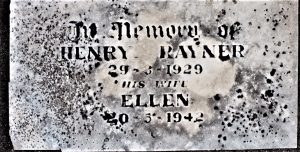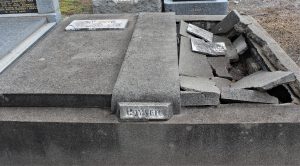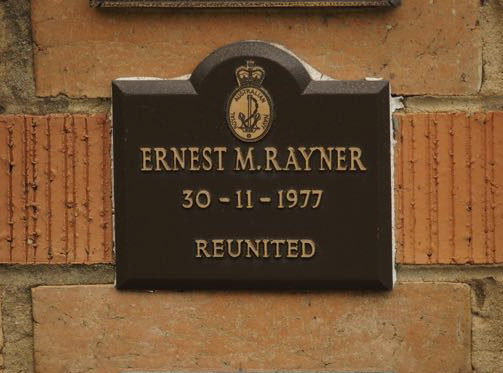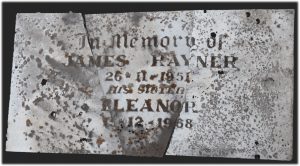Henry and Ellen Rayner were one of the early residents of the Altona district moving into the area around 1890 and building in Mount Street.
Henry was born 31 August 1845 in Northbourne, in County Kent England to parents Henry (1814 – 1859) and Eleanor Rayner nee Marsh (1817 – 1892). Henry was one of thirteen siblings being the fifth born and second eldest son. Henry senior was a farmer, like his father, working land within the Northbourne parish.
At the age 16 Henry had joined the Royal Navy as a Boy Seaman 2nd Class and then at 18 as an Able Seaman. He served on various ships until his last 15 months of service when he was transferred to the ‘Himalaya’ on the 1st June 1872. It was not long after this transfer that the Himalaya was required to join other ships within the Ashanti War on the Gold Coast of Africa. It is believed that Henry may have been one of a large number of members of the Himalaya that received the Ashanti medal. Henry was discharged from the Navy in September 1873 at he then joined the Merchant Navy aboard the ship Northumberland out of the Port of London. It was on this ship that he sailed to Australia and arrived back in England in February 1874 but had fallen in love with Australia.
On February 28 1874 Henry married Ellen Cotterell (1854 – 1942) at Old Windsor, Bershire. It appears that Henry and Ellen met through one of Henry’s Royal Navy shipmates while Ellen was employed as a servant at Windsor Castle. Ellen Cotterell was the daughter of John and Ellen Cotterell nee Searle born 25 January 1854 at Winkfield, Berkshire. They had 10 children Charles Henry, Elizabeth Annie, John, George James, James, Henry Edward, Eleanor Alice, Charlotte Lucy, Violet Mary, and Ernest Moss.
Henry again signed on to the ship the Northumberland which was destined to travel to Australia. His wife Ellen signed onto the same ship as a ‘help’ to Lady Hutton, who was bound for Sydney.
After their arrival the family resided in the Preston area for about four years before Henry joined Victorian naval forces at Williamstown (22-3-1878) and transferred from Navy 22-9-1889 to ordnance department, from there to light house keeper serving at the Otway Lighthouse. Henry came to Altona around this time where he bought property in Mount Street, approximately ¼ acre on the corner of Mount Street and Railway Street South from where he ran a small dairy farm. The house that the family lived in was built by Mr Hick, a builder & carpenter, from Williamstown in 1889. The home was of oregon frame on bluestone foundation, baltic pine weather board exterior – interior tongue & grooved lining galvanised roof – four main rooms, verandah back & front. The back verandah was quite large & there was a detached wash house.
Just after the completion of the house the family moved away from the Altona area and down along the coast to tend at a number of the lighthouses between Queenscliff and Warrnambool. They house was rented out to the Government and was lined with sheets for use as a magazine before the explosives reserve came into operation. There was about a sixteen year period when they were away from Altona and the family may have worked their way down from Queenscliff and Point Lonsdale, through Cape Otway and then to Warrnambool before they returned to their property in Mount Street Altona.
Henry retired at Warrnambool at sixty years of age 1905, on a small government pension. There were no old age pensions or allowance for children. The family returned to live in their home at Mount St Altona 1906 as small farmer, few cows, pigs, fowls, horses and a good 14’ boat for fishing, part of our living.
 Henry passed away from a seizure on Good Friday, 29 March 1929. His obituary notes – “Here he lived, highly respected and liked by all with whom he came in contact, until the day of his final seizure.” Such was his standing within this small community that two of the pall bearers were Councillors Wilcher and Grieve, along with J Duke, A Turner, W Groves, E Starford, L Moss and G Aldridge. Henry is buried within the Church of England section of the Williamstown Cemetery.
Henry passed away from a seizure on Good Friday, 29 March 1929. His obituary notes – “Here he lived, highly respected and liked by all with whom he came in contact, until the day of his final seizure.” Such was his standing within this small community that two of the pall bearers were Councillors Wilcher and Grieve, along with J Duke, A Turner, W Groves, E Starford, L Moss and G Aldridge. Henry is buried within the Church of England section of the Williamstown Cemetery.
Henry was survived by his wife Ellen and their children –  George, James, Henry, Eleanor, Charlotte and Ernest. The sea must have been in young Ernest Moss Rayner’s blood for he enlisted at the age of 17 into the Navy on the 12 November 1912, before WWI had broken out. At the outbreak of WWI, Ordinary Seaman Rayner was serving aboard the HMAS Sydney which was sailing north to join HMAS Australia, both intended to protect the Australian Naval and Military Forces around the Pacific area of Rabaul and Anguar Island. James enlisted into the A.I.F. on 12 February 1916 and following the completion of his basic training was appointed as a Private to the 23rd Battalion at the age of 34 years and 2 months. James and the men from the 12th Reinforcements arrived in England via Egypt to undertake further training before he joined the 23rd Battalion in Belgium in October 1916. There was no gentle introduction to the Western Front, the Battalion at this time was involved in the horrific battles of Pozieres and Mouquet Farm, after which it was estimated that the Battalion lost almost 90 per cent of its original members. Private Rayner suffered an injury to his ankle, November 1916, and was sent for treatment at a field hospital, before being diagnosed suffering trench foot. James returned to his battalion in May 1917 and serviced out the remainder of the war on the Western front in France and Belgium. He returned to Australia and Altona. He begun working at the Explosives Reserve up until about the late 1940’s.
George, James, Henry, Eleanor, Charlotte and Ernest. The sea must have been in young Ernest Moss Rayner’s blood for he enlisted at the age of 17 into the Navy on the 12 November 1912, before WWI had broken out. At the outbreak of WWI, Ordinary Seaman Rayner was serving aboard the HMAS Sydney which was sailing north to join HMAS Australia, both intended to protect the Australian Naval and Military Forces around the Pacific area of Rabaul and Anguar Island. James enlisted into the A.I.F. on 12 February 1916 and following the completion of his basic training was appointed as a Private to the 23rd Battalion at the age of 34 years and 2 months. James and the men from the 12th Reinforcements arrived in England via Egypt to undertake further training before he joined the 23rd Battalion in Belgium in October 1916. There was no gentle introduction to the Western Front, the Battalion at this time was involved in the horrific battles of Pozieres and Mouquet Farm, after which it was estimated that the Battalion lost almost 90 per cent of its original members. Private Rayner suffered an injury to his ankle, November 1916, and was sent for treatment at a field hospital, before being diagnosed suffering trench foot. James returned to his battalion in May 1917 and serviced out the remainder of the war on the Western front in France and Belgium. He returned to Australia and Altona. He begun working at the Explosives Reserve up until about the late 1940’s.
Ellen Rayner remained in the family home in Mount Street and she passed away in May 1942 and is also buried in the Williamstown Cemetery.


